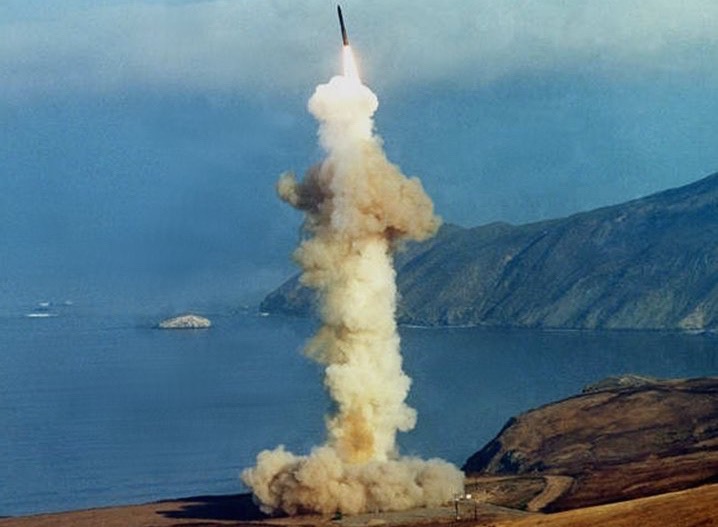Rethinking The Ground-Based Strategic Deterrent

The United States Air Force needs to replace the Minuteman III ICBM fleet at the three nuclear missile bases in Wyoming, Montana, and North Dakota. Critics decry the cost of a proposed replacement, thought to be in the range of several hundred billion dollars. Their main argument against replacing ICBMs is not the cost of replacing the Minuteman III. The critics say we just don’t need them. They are, they say, a “Cold War relic.”
The fact that nuclear peer Russia and near-peer China are modernizing their ICBM forces is often lost on those critics. While the reasons why are debatable, Russia’s recent aggression on a variety of fronts has left many Russia apologists dumbfounded. Russia isn’t just modernizing its ICBMs. At a frequency unprecedented since the Cold War, Russian nuclear-capable bombers are penetrating the American Air Defense Identification Zone’s (ADIZ) in both the continental United States and around Guam. Russia, unlike the US, is investing heavily to modernize their nuclear triad — delivery vehicles and weapons. The Russians seem intent on relying on their nuclear force to counter American conventional military superiority.

Adam Lowther
China likewise is improving its nuclear forces. The DF-41— a multiple reentry vehicle ICBM —was recently tested successfully. They are also working on improving their nuclear submarine capability, placing new submarine-launched ballistic missiles on Jin class nuclear submarines. To deter such capabilities America requires a secure and reliable nuclear deterrent for decades to come.
Why ICBMs?
The fact that the basics of the ICBM mission have not changed much since these systems were first fielded may explain why some believe they are outdated. Before we commit to deactivating this weapon system, it is important to consider some of its benefits.

Col. Robert S. Spalding
First, ICBMs provide an excellent deterrent to nuclear attack on the homeland. The 400-plus Minuteman III silos spread across the American West are invulnerable to all but massive nuclear missile attacks. Thus, their existence sets a high threshold for attacking the United States, either conventionally or with nuclear weapons. Without ICBMs, our strategic nuclear targets shrink from 503 to six, which could all be destroyed with conventional strikes. Only ICBMs require a nuclear strike.
Second, ICBMs cost less than the other two parts of the nuclear triad. While a Minuteman III weapon system replacement will come at a cost; it is likely to prove operationally cost effective over the long term. It is important to remember that ICBMs are used every single day to deter our adversaries.
Building new ICBMs provides the US an opportunity to consider deploying ICBMs in new and creative ways to deter a broader range of future threats. Instead of just procuring a new nuclear-capable ICBM, a common launch vehicle capable of carrying multiple modules might prove a good option.
A New Ground Based Strategic Deterrent
Some non-traditional missions a common launch vehicle might provide include:
Traditional nuclear deterrence works by creating the fear of a massive retaliatory response in the minds of a potential adversary. What if ICBMs could also demonstrate that an adversary’s objectives are beyond reach? Some have speculated that terrorists may not be deterrable using nuclear weapons, and thus the ICBM force is irrelevant against these threats.
In the future, a state or terror group may elect to detonate a nuclear weapon in the upper atmosphere creating an electro-magnetic pulse (EMP). It would not cause direct casualties but it would cause major disruptions to financial and communication systems worldwide. If the US can demonstrate the ability to rapidly restore these systems in the wake of an EMP attack, the incentive to launch such an attack may be diminished.
A prompt conventional strike capability (usually known as Prompt Global Strike — PGS) would also fill a niche role so the US could strike a fleeting terrorist target or rogue regime. Given its cost, only a small number of such weapons would be feasible and useful. They could not effectively replace nuclear ICBMs.
The concern that a nuclear-armed opponent might mistake a launch as a pre-emptive nuclear attack is used against ICBMs providing the PGS capability. However, with today’s improved communications and space situational awareness capabilities the US can offer effective advance notification and assurances to Russia and China, reducing the risks raised by detractors.
Conclusion
While the options for a Minuteman III replacement are still open, what is not debatable is the fact that Russia and China both see ICBMs as critical to their own security. It is now time for the United States to do likewise. When it comes to nuclear deterrence, symmetry of weapons plays an important role in stability. We should not forget that.
Col. Robert S. Spalding III is a B-2 pilot and former military fellow at the Council on Foreign Relations.
Adam Lowther is a professor at the Air Force Research Institute at Maxwell Air Force Base. He specializes in the study of nuclear weapons policy. He was deeply involved in the Commander Directed Investigation about cheating and drug use among missileers at Malmstrom Air Base.
Rethinking The Ground-Based Strategic Deterrent

The United States Air Force needs to replace the Minuteman III ICBM fleet at the three nuclear missile bases in Wyoming, Montana, and North Dakota. Critics decry the cost of a proposed replacement, thought to be in the range of several hundred billion dollars. Their main argument against replacing ICBMs is not the cost of replacing the Minuteman III. The critics say we just don’t need them. They are, they say, a “Cold War relic.”
The fact that nuclear peer Russia and near-peer China are modernizing their ICBM forces is often lost on those critics. While the reasons why are debatable, Russia’s recent aggression on a variety of fronts has left many Russia apologists dumbfounded. Russia isn’t just modernizing its ICBMs. At a frequency unprecedented since the Cold War, Russian nuclear-capable bombers are penetrating the American Air Defense Identification Zone’s (ADIZ) in both the continental United States and around Guam. Russia, unlike the US, is investing heavily to modernize their nuclear triad — delivery vehicles and weapons. The Russians seem intent on relying on their nuclear force to counter American conventional military superiority.

Adam Lowther
China likewise is improving its nuclear forces. The DF-41— a multiple reentry vehicle ICBM —was recently tested successfully. They are also working on improving their nuclear submarine capability, placing new submarine-launched ballistic missiles on Jin class nuclear submarines. To deter such capabilities America requires a secure and reliable nuclear deterrent for decades to come.
Why ICBMs?
The fact that the basics of the ICBM mission have not changed much since these systems were first fielded may explain why some believe they are outdated. Before we commit to deactivating this weapon system, it is important to consider some of its benefits.

Col. Robert S. Spalding
First, ICBMs provide an excellent deterrent to nuclear attack on the homeland. The 400-plus Minuteman III silos spread across the American West are invulnerable to all but massive nuclear missile attacks. Thus, their existence sets a high threshold for attacking the United States, either conventionally or with nuclear weapons. Without ICBMs, our strategic nuclear targets shrink from 503 to six, which could all be destroyed with conventional strikes. Only ICBMs require a nuclear strike.
Second, ICBMs cost less than the other two parts of the nuclear triad. While a Minuteman III weapon system replacement will come at a cost; it is likely to prove operationally cost effective over the long term. It is important to remember that ICBMs are used every single day to deter our adversaries.
Building new ICBMs provides the US an opportunity to consider deploying ICBMs in new and creative ways to deter a broader range of future threats. Instead of just procuring a new nuclear-capable ICBM, a common launch vehicle capable of carrying multiple modules might prove a good option.
A New Ground Based Strategic Deterrent
Some non-traditional missions a common launch vehicle might provide include:
- a capability for providing time critical space assets like sensors, navigation, or communications satellites in response to a contingency;
- traditional missions like: ballistic missile defense; anti-satellite strikes;
- and prompt conventional strike.
Traditional nuclear deterrence works by creating the fear of a massive retaliatory response in the minds of a potential adversary. What if ICBMs could also demonstrate that an adversary’s objectives are beyond reach? Some have speculated that terrorists may not be deterrable using nuclear weapons, and thus the ICBM force is irrelevant against these threats.
In the future, a state or terror group may elect to detonate a nuclear weapon in the upper atmosphere creating an electro-magnetic pulse (EMP). It would not cause direct casualties but it would cause major disruptions to financial and communication systems worldwide. If the US can demonstrate the ability to rapidly restore these systems in the wake of an EMP attack, the incentive to launch such an attack may be diminished.
A prompt conventional strike capability (usually known as Prompt Global Strike — PGS) would also fill a niche role so the US could strike a fleeting terrorist target or rogue regime. Given its cost, only a small number of such weapons would be feasible and useful. They could not effectively replace nuclear ICBMs.
The concern that a nuclear-armed opponent might mistake a launch as a pre-emptive nuclear attack is used against ICBMs providing the PGS capability. However, with today’s improved communications and space situational awareness capabilities the US can offer effective advance notification and assurances to Russia and China, reducing the risks raised by detractors.
Conclusion
While the options for a Minuteman III replacement are still open, what is not debatable is the fact that Russia and China both see ICBMs as critical to their own security. It is now time for the United States to do likewise. When it comes to nuclear deterrence, symmetry of weapons plays an important role in stability. We should not forget that.
Col. Robert S. Spalding III is a B-2 pilot and former military fellow at the Council on Foreign Relations.
Adam Lowther is a professor at the Air Force Research Institute at Maxwell Air Force Base. He specializes in the study of nuclear weapons policy. He was deeply involved in the Commander Directed Investigation about cheating and drug use among missileers at Malmstrom Air Base.
Rethinking The Ground-Based Strategic Deterrent
